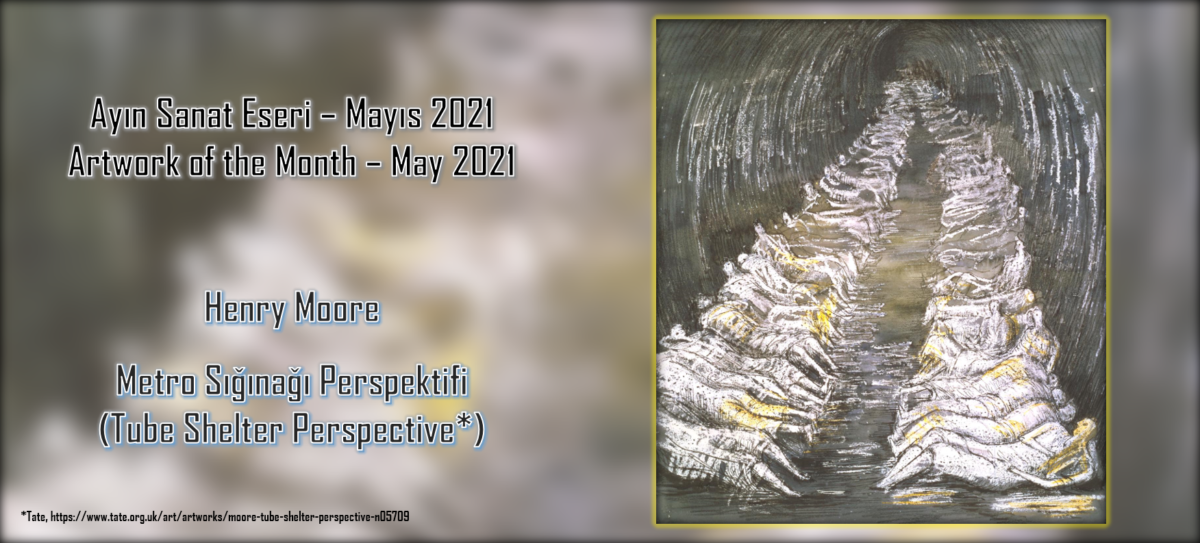Bu ay #GüvenlikPortalı’nın kapak resmi, İngiliz sanatçı Henry Moore’un 1941 tarihli #MetroSığınağıPerspektifi (Tube Shelter Perspective).
Britanya’nın en önemli heykeltıraşlarından Henry Moore, İkinci Dünya Savaşı sırasında metro tünellerine sığınan insanlardan etkilenmiş ve 1940-1941 tarihleri arasında bu konuda çizimler yapmıştır. Füzen, kalem, suluboya gibi teknikler kullanarak yaptığı bu serisinin bir parçası olan “Metro Sığınağı Perspektifi eseri”, dönemin koşullarını resmin atmosferinde ortaya koymaktadır. Resmin solukluğu, metronun karanlığı ve uçsuz bucaklığı, insanların savaş dönemindeki psikolojik durumlarını aktarır gibidir. Figürlerin net olmayan, kargacık burgacık denebilecek şekilde görünmesi, birbirine benzer şekilde uzanmış halde yatmaları ‘çaresizliklerini’, tünelin devamına doğru seçilmez hale gelmeleri de ‘savaş sırasında insanların sadece hayatta kalmaya çalışan birer insan’ haline indirgenmişliğini gözler önüne sermektedir. Resim, bu noktada tekniğinden çok yaşananı şiirsel bir dille aktarımı nedeniyle çarpıcıdır.
Eylül 1940-Mayıs 1941 arasında Almanya’nın Britanya’yı yoğun bombardımanla (The Blitz) sarsarak binlerce sivilin hayatını kaybetmesine yol açtığı hava saldırıları boyunca, Moore 300’den fazla çizim yapmıştır. Altı evden birinin yıkıldığı bu bombardımanlar sonucu pek çok insan evsiz kalmıştır. Bombalardan korunmak için Londra metrosu sığınağa dönüşmüş ve insanlar metro tünellerinde bombardımanın bitmesini beklemişlerdir. Moore Londra’daki evine gidiş gelişlerde metrodaki bu insanları görmekteydi. Yetişkin ve çocuk pek çok insanın bir arada, koyun koyuna, battaniyeler altında uzanıp bekleyen bu hallerini kendinde yarattığı duyguları da katarak aktarmanın yolunu yaptığı bu çizimlerde bulmuştu. Çizimlerini arkadaşlarına göstermesinden bir süre sonra da Çalışma Bakanlığının savaş döneminde sanatçılara destek olmak için kurduğu ‘Britanya savaş sanatçıları’ arasına katılmıştır. Bombardımanların başlamasından kısa süre sonra kendi evi ve stüdyosu da zarar gördüğü için Londra’nın dışına taşınmak zorunda kalmıştır ve bugün hala Moore Vakfı’na ait olan araziye yerleşmiştir.
***
This month’s artwork of the #SecurityPortal is British artist Henry Moore’s 1941 painting #TubeShelterPerspective.
Henry Moore, one of Britain’s most significant sculptors, was influenced by the people who took shelter in the subway tunnels during World War II and made drawings on this subject between 1940-1941. “Tube Shelter Perspective” is a part of this series, which he created by using techniques such as charcoal, pen, and watercolor, and reveals the conditions of the period in the atmosphere of the painting. The paleness of the painting, the darkness of the subway, and its immense vastness seem to convey the psychological conditions of the people during the war. The similar unclearness and wrinkly shapes of the figures depict their desperation. The figures that become indistinguishable towards the rest of the tunnel during the war show that the people there are just seen as human beings trying only to ‘survive’. At this point, the painting is striking, rather than its technique, because of its poetic reflection of what was experienced.
During the German air strikes between September 1940 and May 1941, when Germany shook Britain with intense bombardment (The Blitz), thousands of civilians were killed; Moore made created than 300 drawings. Many people lost their houses as a result of the bombardment that destroyed one of the six houses. In order to be protected from the bombs, the London subway turned into a shelter and people waited for the bombing in the subway tunnels to end. Moore was seeing these people on the subway while he was on the way to back home from work in London. He considered in these drawings a way to convey his emotions regarding the adults and the children who were lying and waiting under blankets side by side. After he showed his drawings to his friends, he was awarded as one of the “British war artists” that the Ministry of Labour initiated to support artists during the war. Shortly after the bombings began, he had to move out of London as his own home and studio were also damaged, and he settled on a land that still belongs to the Moore Foundation today.
KAYNAKÇA/BIBLIOGRAPHY
- Florence Hallet, “Henry Moore: The Artist in Wartime”, The Tretyakov Gallery Magazine, Magazine Issue 1, 2020, https://www.tretyakovgallerymagazine.com/articles/1-2020-66/henry-moore-artist-wartime.
- “The Blitz”, Britannica, https://www.britannica.com/event/the-Blitz#ref345826.
RESİM/PAINTING
- “Henry Moore OM, CH: Tube Shelter Perspective, 1941”, Tate, https://www.tate.org.uk/art/artworks/moore-tube-shelter-perspective-n05709.

